Kathakali
Kathakali is a stylized classical Indian dance-drama noted for the attractive make-up of characters, elaborate costumes, detailed gestures and well-defined body movements presented in tune with the anchor playback music and complementary percussion. It originated in the country's present day state of Kerala during the 17th century and has developed over the years with improved looks, refined gestures and added themes besides more ornate singing and precise drumming.

Mohiniyattam
Mohiniyattamis a classical dance form from Kerala, India. Believed to have originated in 16th century CE, it is one of the eight Indian classical dance forms recognized by the Sangeet Natak Akademi. It is considered a very graceful form of dance meant to be performed as solo recitals by women.
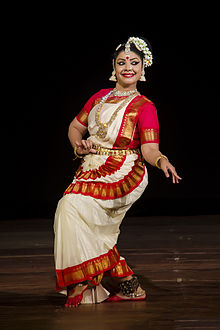
Thiruvathira
Thiruvathirakali is a dance performed by women, in order to attain everlasting marital bliss, onThiruvathira day in the Malayalam month of Dhanu (December- January). The dance is a celebration of marital fidelity and the female energy, for this is what brought Kamadeva (the god of love) back to life after he was reduced to ashes by the ire of Lord Siva.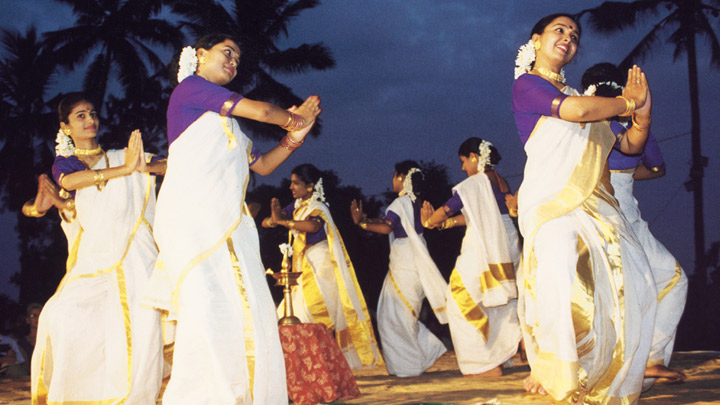
Margam Kali
Margamkali is a group dance of Kerala practiced by Jewish Christians (also known as Knanaya or Nasrani) who trace their origins to the evangelistic activity of Thomas the Apostle among Jews and natives in the 1st century

Kerala Nadanam
Kerala Nadanamis a new style of dance that is now recognised as a distinct art form evolved from Kathakali, a form of Indian dance-drama. The Indian dancer Guru Gopinath a well-trained Kathakali artist and his wife Thankamani Gopinath who was the first student of Mohiniyattam in KeralaKalamandalam developed a unique structure for teaching and performing classical dance forms of India whose origins are from Kathakali. Solo, duets, dance dramas and traditional folk dances were the material they chose.
Oppana
Oppana is a popular form of social entertainment among the Mappila (Kerala Muslim's) community of Kerala, south India, prevalent all over kerala especially in Malappuram. The Malayalam word Oppana Pattu is the derivation of Tamil word 'Oppanai Pattu'. In Tamil 'Oppanai' means make up.Oppana was originated on the occasion of make of Muslim brides. Now Oppana has been extinct in Tamil Nadu. But in Kerala this art form has been revived with much popularity in performing stages of Youth Festivals of student community.

Ottanthullal
Ottanthullal is an art form Kerala state, India. It was introduced in the 1700s by Kunchan Nambiar, one of the Prachina Kavithrayam (three famous Malayalam language poets). It is accompanied by a mridangam or an idakka (drum and cymbal)

Sheethangan Thullal
A classical solo distinct for its wit, humour and presented in slower in metre, rhythm and tempo compared to other Thullal forms.
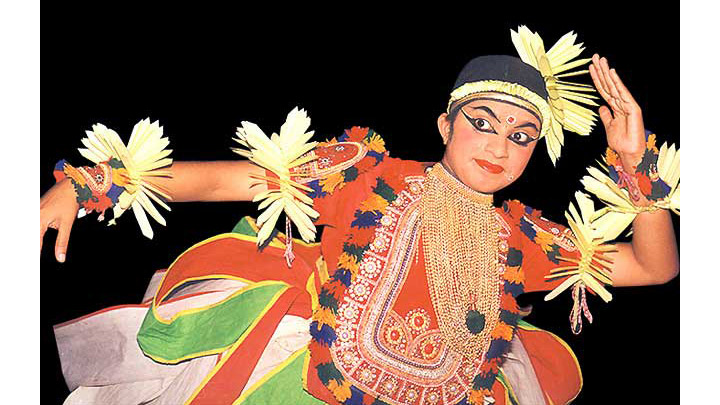
Nadodi Nritum
Nadodi means tribal people or nomads who dress entirely different from normal people. Nritham means dance. So nadodi nritham is an art form performed in the costume of tribes and villagers.
Nadodis often perform different art items as a part of their celebrations and happiness. They carry some strange instruments as well as equipments. They are not much civilized till now. That’s the reason why, when this folk item is performed on stage, participants wear colourful dresses, big bindi, thick eye brows and heavy make up. They wear glass bangles and anklets with bells.
Kalaripayattu is a Martial art which originated as a style in south India during 2nd century BC to the 2nd century AD. The word kalari first appears in Sangam literature to describe both a battlefield and combat arena. The word kalari tattdenoted a martial feat, while kalari kozhai meant a coward in war. Each warrior in the Sangam era received regular military training. It is considered to be one of the oldest fighting system in existence. It is now practiced in Kerala, in contiguous parts of Tamil Nadu. It was originally practiced in northern and central parts of Kerala and the Tulunadu region of Karnataka.

Theyyam
Theyyam is a popular ritual form of worship of North Malabar in Kerala, India, predominant in the Kolathunadu area (consisting of present-day Kasargod, Kannur Districts, Mananthavady Taluk of Wayanad andVadakara and Koyilandy Taluks of Kozhikode of Kerala) and also in Kodagu and Tulu nadu of Karnataka as a living cult with several thousand-year-old traditions, rituals and customs. The performers of Theyyam belong to the lower caste community, and have an important position in Theyyam.People of these districts consider Theyyam itself as a God and they seek blessings from this Theyyam. A similar custom is followed in the Tulu Nadu region of neighbouring Karnataka known as Bhuta Kola.
Theyyam is a popular ritual form of worship of North Malabar in Kerala, India, predominant in the Kolathunadu area (consisting of present-day Kasargod, Kannur Districts, Mananthavady Taluk of Wayanad andVadakara and Koyilandy Taluks of Kozhikode of Kerala) and also in Kodagu and Tulu nadu of Karnataka as a living cult with several thousand-year-old traditions, rituals and customs. The performers of Theyyam belong to the lower caste community, and have an important position in Theyyam.People of these districts consider Theyyam itself as a God and they seek blessings from this Theyyam. A similar custom is followed in the Tulu Nadu region of neighbouring Karnataka known as Bhuta Kola.
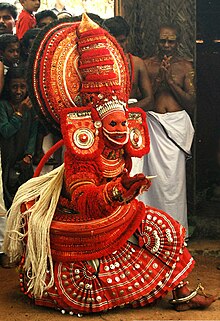
Velakali
Velakali is a traditional martial dance of Kerala that is performed by the Nair community during temple festivals. Brightly dressed dancers wielding swords and shields depict a fight sequence between the Pandavas and Kauravas during the course of the dance
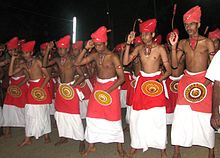
Garuden Parava

Tribal Dance
Tribal dance forms of Kerala reflect the tradition and rituals of the land and reveal all its cultural glory. Kerala has more than thirty five different types of tribal dances, like, Elelakkaradi, Paniyarkali, Mullakurumbar, Uralikurumbar, Paniya, and Mankali to name a few. Certain tribal dances are accompanied by songs. Either the dancers themselves sing or the on-lookers sing and thus participating in the performances. Special musical instruments are sometimes used butdrum is almost an indispensable feature of the tribal dance forms in Kerala.

Tribal Theyyam

Parichmuttukali
Parichamuttukali is a martial dance form of Kerala practiced by Saint Thomas Christians (also known as Syrian Christians or Nasrani) who trace their origins to the evangelistic activity of Thomas the Apostle among Jews and natives in the 1st century. It is performed by men bearing swords and shields and follows the movements and steps of Kalarippayattu.

Vadithallu
Vadithallu is one of the performing arts of Kerala almost similar to Kolkali and in this folk dance artists hold short sticks in their both hands and tap while dance around.

Kolkali
Kolkali is a folk art performed in North Malabar region of Kerala State in south India. The dance performers move in a circle, striking small sticks and keeping rhythm with special steps. The circle expands and contracts as the dance progress. The accompanying music gradually rises in pitch and the dance reaches its climax.
Kotta Kvavdi

Mayoora Nritham

Arjuna Dance

Mudiyattam

Velakali is a traditional martial dance of Kerala that is performed by the Nair community during temple festivals. Brightly dressed dancers wielding swords and shields depict a fight sequence between the Pandavas and Kauravas during the course of the dance

Garuden Parava

Tribal Dance
Tribal dance forms of Kerala reflect the tradition and rituals of the land and reveal all its cultural glory. Kerala has more than thirty five different types of tribal dances, like, Elelakkaradi, Paniyarkali, Mullakurumbar, Uralikurumbar, Paniya, and Mankali to name a few. Certain tribal dances are accompanied by songs. Either the dancers themselves sing or the on-lookers sing and thus participating in the performances. Special musical instruments are sometimes used butdrum is almost an indispensable feature of the tribal dance forms in Kerala.
Tribal Theyyam
Parichmuttukali
Parichamuttukali is a martial dance form of Kerala practiced by Saint Thomas Christians (also known as Syrian Christians or Nasrani) who trace their origins to the evangelistic activity of Thomas the Apostle among Jews and natives in the 1st century. It is performed by men bearing swords and shields and follows the movements and steps of Kalarippayattu.
Vadithallu
Vadithallu is one of the performing arts of Kerala almost similar to Kolkali and in this folk dance artists hold short sticks in their both hands and tap while dance around.
Kolkali
Kolkali is a folk art performed in North Malabar region of Kerala State in south India. The dance performers move in a circle, striking small sticks and keeping rhythm with special steps. The circle expands and contracts as the dance progress. The accompanying music gradually rises in pitch and the dance reaches its climax.
Kotta Kvavdi

Mayoora Nritham
Arjuna Dance
Mudiyattam

No comments:
Post a Comment